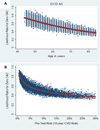Role of Coronary Artery Calcium Score of Zero and Other Negative Risk Markers for Cardiovascular Disease: The Multi-Ethnic Study of Atherosclerosis (MESA)
- PMID: 26801055
- PMCID: PMC4775391
- DOI: 10.1161/CIRCULATIONAHA.115.018524
Role of Coronary Artery Calcium Score of Zero and Other Negative Risk Markers for Cardiovascular Disease: The Multi-Ethnic Study of Atherosclerosis (MESA)
Abstract
Background: Limited attention has been paid to negative cardiovascular disease (CVD) risk markers despite their potential to improve medical decision making. We compared 13 negative risk markers using diagnostic likelihood ratios (DLRs), which model the change in risk for an individual after the result of an additional test.
Methods and results: We examined 6814 participants from the Multi-Ethnic Study of Atherosclerosis. Coronary artery calcium score of 0, carotid intima-media thickness <25th percentile, absence of carotid plaque, brachial flow-mediated dilation >5% change, ankle-brachial index >0.9 and <1.3, high-sensitivity C-reactive protein <2 mg/L, homocysteine <10 µmol/L, N-terminal pro-brain natriuretic peptide <100 pg/mL, no microalbuminuria, no family history of coronary heart disease (any/premature), absence of metabolic syndrome, and healthy lifestyle were compared for all and hard coronary heart disease and all CVD events over the 10-year follow-up. Models were adjusted for traditional CVD risk factors. Among all negative risk markers, coronary artery calcium score of 0 was the strongest, with an adjusted mean DLR of 0.41 (SD, 0.12) for all coronary heart disease and 0.54 (SD, 0.12) for CVD, followed by carotid intima-media thickness <25th percentile (DLR, 0.65 [SD, 0.04] and 0.75 [SD, 0.04], respectively). High-sensitivity C-reactive protein <2 mg/L and normal ankle-brachial index had DLRs >0.80. Among clinical features, absence of any family history of coronary heart disease was the strongest (DLRs, 0.76 [SD, 0.07] and 0.81 [SD, 0.06], respectively). Net reclassification improvement analyses yielded similar findings, with coronary artery calcium score of 0 resulting in the largest, most accurate downward risk reclassification.
Conclusions: Negative results of atherosclerosis-imaging tests, particularly coronary artery calcium score of 0, resulted in the greatest downward shift in estimated CVD risk. These results may help guide discussions on the identification of individuals less likely to receive net benefit from lifelong preventive pharmacotherapy.
Keywords: biomarkers; calcium; cardiac imaging techniques; cardiovascular diseases; risk assessment.
© 2016 American Heart Association, Inc.
Figures



Comment in
-
Risk factors: Negative risk markers for CVD.Nat Rev Cardiol. 2016 Mar;13(3):122. doi: 10.1038/nrcardio.2016.21. Epub 2016 Feb 11. Nat Rev Cardiol. 2016. PMID: 26864915 No abstract available.
References
-
- 27th Bethesda Conference. Matching the Intensity of Risk Factor Management with the Hazard for Coronary Disease Events. September 14–15, 1995. J Am Coll Cardiol. 1996;27:957–1047. - PubMed
-
- World Health Organization. Global Status Report on Non-communicable Diseases 2010. Geneva, Switzerland: World Health Organization; 2011.
-
- Kildemoes HW, Andersen M, Støvring H. The impact of ageing and changing utilization patterns on future cardiovascular drug expenditure: a pharmacoepidemiological projection approach. Pharmacoepidemiol Drug Saf. 2010;19:1276–1286. - PubMed
-
- Karmali KN, Goff DC, Jr, Ning H, Lloyd-Jones DM. A systematic examination of the 2013 ACC/AHA pooled cohort risk assessment tool for atherosclerotic cardiovascular disease. J Am Coll Cardiol. 2014;64:959–968. - PubMed
-
- Pencina MJ, Navar-Boggan AM, D’Agostino RB, Sr, Williams K, Neely B, Sniderman AD, Peterson ED. Application of new cholesterol guidelines to a population-based sample. N Engl J Med. 2014;370:1422–1431. - PubMed
Publication types
MeSH terms
Substances
Grants and funding
- N01-HC-95162/HC/NHLBI NIH HHS/United States
- N01 HC095161/HL/NHLBI NIH HHS/United States
- N01 HC095168/HL/NHLBI NIH HHS/United States
- L30 HL110027/HL/NHLBI NIH HHS/United States
- N01-HC-95165/HC/NHLBI NIH HHS/United States
- N01 HC095159/HL/NHLBI NIH HHS/United States
- UL1-TR-000040/TR/NCATS NIH HHS/United States
- N01 HC095163/HL/NHLBI NIH HHS/United States
- N01 HC095166/HL/NHLBI NIH HHS/United States
- UL1 TR001079/TR/NCATS NIH HHS/United States
- N01 HC095169/HL/NHLBI NIH HHS/United States
- N01-HC-95163/HC/NHLBI NIH HHS/United States
- N01-HC-95168/HC/NHLBI NIH HHS/United States
- N01-HC-95159/HC/NHLBI NIH HHS/United States
- N01 HC095167/HL/NHLBI NIH HHS/United States
- N01-HC-95169/HC/NHLBI NIH HHS/United States
- N01-HC-95164/HC/NHLBI NIH HHS/United States
- UL1 TR001420/TR/NCATS NIH HHS/United States
- N01-HC-95160/HC/NHLBI NIH HHS/United States
- N01-HC-95161/HC/NHLBI NIH HHS/United States
- UL1 TR000040/TR/NCATS NIH HHS/United States
- N01 HC095162/HL/NHLBI NIH HHS/United States
- N01-HC-95166/HC/NHLBI NIH HHS/United States
- N01 HC095165/HL/NHLBI NIH HHS/United States
- N01 HC095164/HL/NHLBI NIH HHS/United States
- N01-HC-95167/HC/NHLBI NIH HHS/United States
- N01 HC095160/HL/NHLBI NIH HHS/United States
LinkOut - more resources
Full Text Sources
Other Literature Sources
Medical
Research Materials

